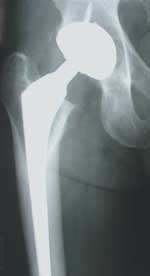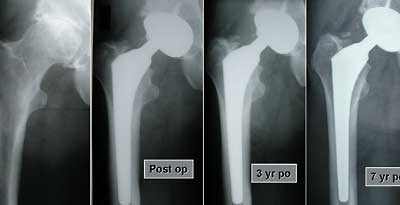Ceramic-on-ceramic bearing surfaces for THR: Is this the right generation?
Alumina-on-alumina ceramic bearings show promise but concerns linger about these surfaces.
 Ceramic-on-ceramic bearing surfaces have been used worldwide in total hip replacement for more than 30 years and for more than five years in the United States. Early generations of the implants sometimes had less-than-desirable results, including a 2001 recall of zirconia-ceramic heads. New technology, designs, and manufacturing processes and standards, however, have renewed interest in ceramics as an alternate-bearing surface.
Ceramic-on-ceramic bearing surfaces have been used worldwide in total hip replacement for more than 30 years and for more than five years in the United States. Early generations of the implants sometimes had less-than-desirable results, including a 2001 recall of zirconia-ceramic heads. New technology, designs, and manufacturing processes and standards, however, have renewed interest in ceramics as an alternate-bearing surface.
At the American Academy of Orthopaedic Surgeons 72nd Annual Meeting, orthopedic researchers addressed the pros and cons of ceramic as a bearing surface material in total hip replacement (THR). Armed with personal experience, data and published literature, William N. Capello, MD, and Robert L. Barrack, MD, discussed the place of this bearing surface in THR.
Unmatched wear resistance
| ||
“There is no question that where the ceramic bearing really excels is in the wear resistance,” said Capello, professor of orthopedic surgery at Indiana University School of Medicine in Indianapolis. “There is nothing available today that I am aware of that matches the ability to resist wear over time.”
He said that although ceramics are scratch resistant, they have the potential for breakage and noise, and lack surgical versatility.
Capello presented data from his prospective, randomized investigation of three- to seven-year follow-up with alumina-on-alumina ceramic bearings. The research, which involved 328 hips, began in 1996 and compares two versions of the Alumina Bearing Couple hip (Stryker Orthopaedics), one with a porous coated titanium shell and one with an HA-coated titanium shell, and a cobalt chrome and polyethylene bearing control. The population was mostly young arthritic men.
He found no ceramic failures or ceramic bearing failures at 5.2 years. Osteolysis was found in 18% of the control group and 1.4% of the ceramic bearing groups. In addition, revision rates were 2.7% for the ceramic groups compared to 7.5% for the control group.
New processes
Capello noted that some early ceramic bearings broke, which was related, in part, to the material itself. Manufacturing processes at that time resulted in some ceramics with large grain sizes, occlusions and irregular grain bondings.
“The new generation of ceramics is produced by a hot isostatic pressing process that better controls the size of the particles,” he said. “There is a seen relationship between strength and size of particles.”
Capello said that the ceramic bearings have many advantages and they outweigh any disadvantages the implants may have. “Clinically, they are performing as we had hoped; there is no measurable wear to date. There have been no reported breakages, [and] what change we have seen is quite minimal. It has remained, at least in my hands, a very good choice for our active patients.”
Concerns exist
Barrack countered Capello’s assertions with published data and experience. “It is true that ceramics have a long track record, particularly in Europe where they have been used for more than 30 years. The initial results were mixed. The hope is [that] better manufacturing should translate into a lower complication rate and improved clinical results. Yet, even with these substantial improvements, a number of concerns exist.” Barrack is Charles F. and Joanne Knight Distinguished Professor of Orthopaedic Surgery at Washington University School of Medicine in St. Louis.
Fracture potential, the difficulty of revising a failure of these components, impingement and loss of options are Barrack’s chief concerns. Fracture and chipping are serious but rare complications. Of concern in a much higher percentage of cases is impingement and the dramatic loss of head and liner options.
Retrieval studies have shown that impingement of the neck of the stem with the liner occurs in a high percentage of cases. With a metal-on-polyethylene articulation, impingement leads to increased wear of the rim over a period of years. With a ceramic-ceramic articulation, impingement occurs between the metal neck and a less forgiving ceramic liner or an elevated metal rim designed to protect the ceramic liner. This has led to early failure in several cases.
Ceramic-ceramic bearings also give surgeons a fraction of the options of a metal-on-polyethylene bearing, which allows for multiple liner types, head diameters and neck lengths. These numerous options help minimize the risk of instability and limb length discrepancy, which are two major operative complications of THA.
|
Modular complications
Another concern: whether the modular interfaces of the ceramic designs generate unexpected responses seen in the early polyethylene and metal acetabular component, Barrack said. Retrievals have shown that even slightly off-center liner impaction can lead to ceramic chipping.
“This early chipping that we have seen is a unique complication and has caused redesign of a number of components — if you impact these off-center by as much as 5º it risks chipping,” Barrack said. This, he added, could become a problem with minimally invasive surgery (MIS) as far as getting perfect concentric placement of the liner in the shell. “If you are off by 5º or more, a chip can occur. This is a little more technically difficult than the standard THR with MIS, which is now the trend. I think ceramics is a little less user-friendly when using a smaller incision,” he said.
When a ceramic fracture does occur, subsequent revision is not going to be easy. “By the time revision takes place, there is so much tissue damage and possible damage to the tibia that maybe the stem will have to be removed, even though it is well fixed due to extensive taper damage.
“These are still going to break and the corollary is that when they break it will not result in a minor change,” Barrack said. “You will often have a complete revision, and this revision will be more of a problem to subsequent revisions.”
Dr. Capello is a consultant to Stryker Orthopaedics.
Dr. Barrack receives royalties from Smith & Nephew Orthopaedics.
For more information:
- Capello WN. Alumina-on-alumina ceramic bearings: 3-7 year follow-up.
- Barrack RL. Concerns with ceramics in THA. Both presented as part of the AR Hip Symposium at the American Academy of Orthopaedic Surgeons 72nd Annual Meeting. Feb. 23-27, 2005. Washington.


